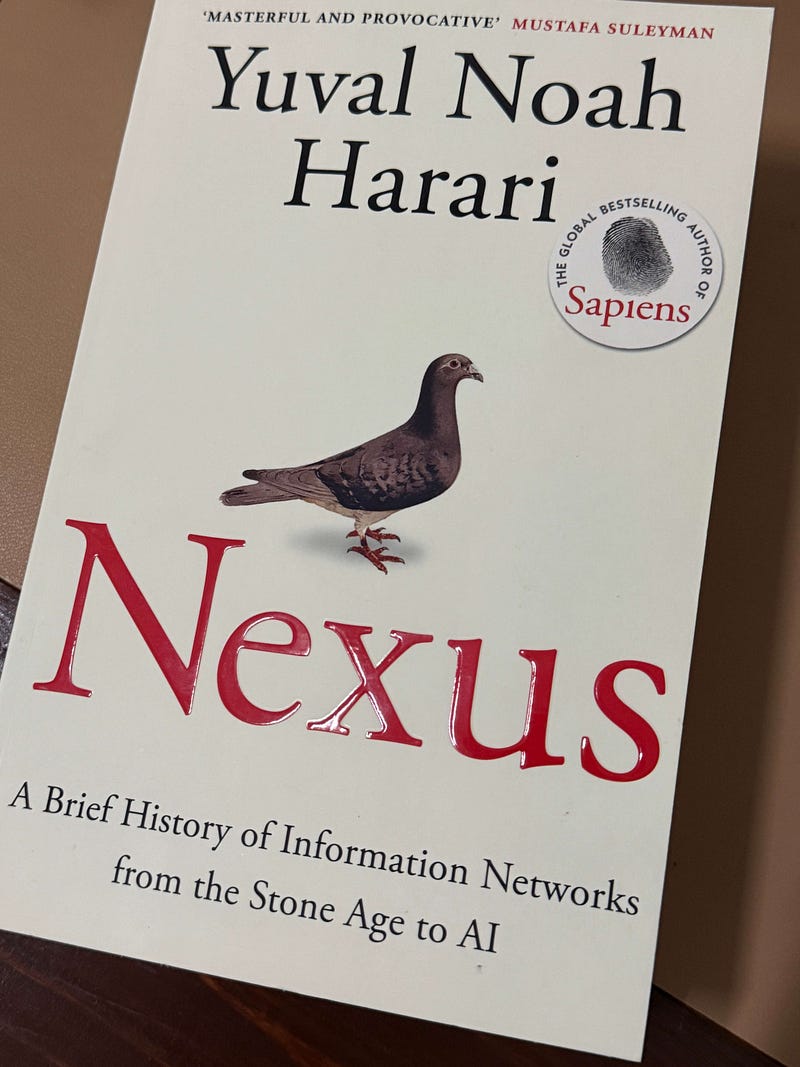
A close look at Harari’s Nexus Chapter 2 and its blind spots
Yuval Noah Harari has a simple but unsettling claim. Humans dominate Earth, not through raw strength or unmatched intellect, but through our talent for shared fiction. Chapter 2 of Nexus, “Stories: Unlimited Connections,” explores that idea at length. Harari argues that narrative lets millions of strangers act in concert, while ants rely on instinct and chimpanzees rely on personal bonds.
Shared stories free us from the ceiling that biology places on face-to-face trust.
From Family Circles to Story Chains
Imagine a late Stone Age campfire. Thirty hunters share food, gossip, and warnings about nearby predators. Trust flows through personal memory: I share meat with those who once shared with me. Anthropologists suggest the practical size limit of such a kin-and-friend network sits around 150. Beyond that point, few can track who earned or broke favor.
Harari contends that language shattered this limit. Once a group can swap myths about spirits, totems, or heroic ancestors, cooperation no longer depends on firsthand knowledge. Two strangers meet and need only confirm devotion to the same tale to treat each other as allies. Bonds shift from direct person-to-person ties to person-to-story-to-person networks. Scale changes everything:
- The Catholic Church links roughly 1.4 billion believers through Bible stories, liturgy, and ritual.
- The modern trade network joins about 8 billion consumers through the shared fiction of currency, contracts, and brand trust.
No ant colony comes close to that reach, and no primate troop ever will. Narrative works as a social operating system that lets small minds build large worlds.
Objective, Subjective, and Intersubjective Reality
Harari draws a three-part map of reality:
- Objective facts persist whether anyone notices. Gravity pulls apples toward the ground, and the Andromeda Galaxy spins on even if every human forgets its name.
- Subjective feelings live inside one skull. My toothache vanishes for everyone else the moment I stop complaining.
- Intersubjective truths sit in the space between minds. Money, traffic laws, and corporations owe their force to shared human agreement. Harari adds that even religious belief, viewed through a purely sociological lens, operates in this intersubjective space.
A sonar rig can confirm or refute a monster in Loch Ness. No instrument can determine whether “Palestine” counts as a sovereign state. That answer shifts with political recognition, UN votes, and popular sentiment. Intersubjective entities wield real power. They raise armies, move markets, and redraw borders, yet they dissolve the instant collective belief collapses.
Harari often illustrates this point with money. In 2010 a Florida programmer traded 10,000 BTC for two pizzas. A decade later those coins traded near $690 million. The caloric content of cheese and dough never changed; community faith in Bitcoin did. Lock the same programmer on a desert island with the bills or private keys in his backpack and buy nothing from the crabs.
Propaganda, Branding, and the Craft of Mass Perception
If stories steer cooperation, people who master storytelling steer the crowd. Harari’s choice examples span dictators, pop stars, and fizzy drinks.
Stalin, the man behind “Stalin”
Joseph Stalin once scolded his son Vasily for boasting of family privilege. The elder Stalin pointed to the portraits on state buildings and reminded the boy that the image called “Stalin” commanded loyalty, not the fallible man himself. Millions feared and loved a paper colossus built by press releases, staged photographs, and choreographed parades.
The celebrity brand
Modern influencers rely on a similar split. A superstar with 200 million followers rarely writes every tweet or edits every photo; instead, a team curates a persona that fans defend as if they know the artist personally. Conflict erupts when leaked footage reveals the gulf between brand and body.
The Coke illusion
Coca-Cola spent tens of billions on ads that pair a brown sugary drink with surfboards, jukeboxes, and smiling teenagers. Over time many viewers link the flavor to freedom and youth rather than tooth decay or plastic waste. That emotional transfer is pure narrative work. Remove the story, and you hold flavored water.
A shrewd storyteller can also reverse a reputation. A corrupt tycoon, armed with airtime and rehearsed slogans, rebrands as a guardian of the poor. A clumsy public servant rebrands as a genius strategist once cable news repeats the line often enough. Harari warns: whoever shapes the communal myth gains the steering wheel, even if the map is wrong.
When Fiction Eclipses Fact
Narrative power frightens because people often believe their own myths. Harari stresses that most founders of great creeds did not set out to deceive. They spoke from conviction, and later followers embroidered details until stories towered over evidence.
Jesus: from village teacher to cosmic deity
Secular historians grant that Jesus of Nazareth preached in first-century Judea and was executed by Rome. Harari argues that later generations enlarged the story until Jesus became acknowledged worldwide as Lord of creation. Many Christian scholars respond that this high view appears already in New Testament texts such as Philippians 2:6‑11 and John 1:1‑14. As a believer, I find their reading more persuasive. Today, paintings and films often show a white-robed figure with a trimmed beard, though no record hints at His face. Billions direct prayer, charity, and policy around that artistic image.
Cher Ami: the feathered war hero that wasn’t
U.S. lore celebrates Cher Ami, a carrier pigeon said to save a “lost battalion” in 1918 despite bullet wounds. Recent archival digs show the battalion’s position was known before the bird arrived, and the stuffed specimen in the Smithsonian may not match the original pigeon. The legend spread because the U.S. Signal Corps needed a morale booster, newspapers wanted a heartwarming story, and Hollywood later sealed the memory with film.
Nazi Germany: catastrophe by captivating myth
Germany’s 1933 election offered voters several competing narratives. Adolf Hitler promoted a story of racial rebirth and economic revenge. Many citizens, worn down by hyperinflation and the humiliation of Versailles, embraced it. That story, rather than material conditions alone, steered the country toward disaster. Other narratives, whether liberal, socialist, or Catholic, failed to command equal theatrical force.
Noble Lies, Scripture, and the Slavery Puzzle
Plato coined the term “noble lie” for myths that keep a city stable. Harari argues that nations, religions, and companies still rely on such foundational tales.
The Ten Commandments provide a sharp case. Commandment Ten forbids coveting a neighbor’s house, wife, ox, or male and female slaves. On a plain reading, the verse assumes a master–servant system that clashes with modern ethics. Many Christians interpret it through later revelation, such as Galatians 3:28 and Paul’s appeal to Philemon, passages they believe nudge believers toward emancipation. Harari cites the text to show how sacred stories can lock old norms in place.
Yet the matter is more layered. Jewish and Christian commentators have long wrestled with that clause, reinterpreting it or reading it as a step toward later emancipation. Their efforts prove Harari’s core point: whenever a community admits that a story is human-made, it can revise the script to fit new ethics. When believers insist the tale dropped from heaven in final form, reform stalls.
Truth and Order: A Perilous Balance
Any information network faces two missions:
- Discover reality. Science, journalism, and audit teams check claims against evidence.
- Maintain cohesion. Shared values and identities keep a group from splintering.
Those aims collide. Brutal facts can tear unity; soothing fabrications can steer policy off a cliff. Today the internet spreads data at lightning speed while algorithms reward outrage and emotional certainty. The result is a carnival where careful studies compete with conspiracy memes for the same slot in a newsfeed.
Harari’s triangle diagram, though absent here, underlines a lesson: better bandwidth does not guarantee better judgment. Societies that privilege myth alone risk delusion; societies that chase fact with no binding narrative risk paralysis or tribal bickering. Thriving cultures juggle both, though the motion never stays steady for long.
Toward Narrative Literacy
Stories built cathedrals, stock exchanges, and the laws that guard human rights. They also fueled witch hunts, pogroms, and genocides. The tool cuts both ways, so vigilance matters.
Harari’s chapter invites readers to treat every banner, sermon, slogan, and brand jingle as a potential plotline that seeks recruits. Ask first: Does the tale align with evidence? Ask next: Whose interests ride on my belief? Then decide whether to endorse, amend, or discard it.
Large-scale cooperation always rests on shared narrative: stories we hold in common, whether they recount verifiable events or convey deeper meaning. That need not trouble us if we remember one rule: we write the scripts. We can revise them whenever compassion, reason, or simple survival demands a new draft. The future hinges on our willingness to edit and on our skill at telling stories that bind without blinding.
Viz

Become a subscriber receive the latest updates in your inbox.






Member discussion